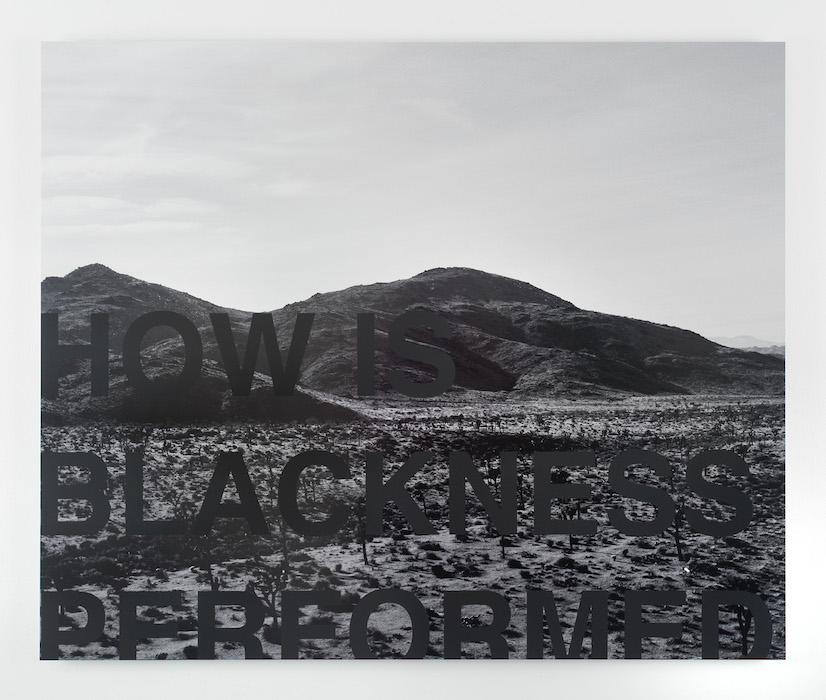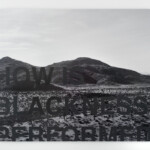Exhibition
in New York, NY / United States
- Kevin Claiborne: PERFORMED, 2020, silkscreen on archival pigment print, 40.35 x 48.25 in
In the time of pandemic and protest, the poet and photographer Kevin Claiborne is asking urgent, necessary questions. They are the questions long unanswered, that have placed Black people at the center of this moment, where they are disproportionately affected. His relentless performance of inquiry is the project, “Blackness Is” (2020-), that sees his questions married to landscapes in an admixture that form images that represent, what he calls, the “body as border:”
“What is Black?
What is Blackness?
Who defines Black?
Who can say Nigga?
How Black must they be?
Who is the Blackest?
How does Blackness manifest?
Who can claim Blackness?
Are all Blacks Black?
Is Blackness quantifiable?
Where does Blackness exist?
Does the one drop rule still apply?
How many drops are necessary?
How much time does it take to be Black?
Do Black people exist in the future?…”
Earlier this year, on a trip to Joshua Tree, in the Mojave Desert, Claiborne began writing down the questions that came to him that he considered as a way to get to the core of Blackness. “In Joshua Tree,” he explains, “I started thinking about the relationship between the environment and Black people’s identity development in beautiful yet potentially harmful places.” This process he describes as “deep and absurd” led to more questions: “What are the core tenets of blackness? Is it ethnicity? Is it background? Is it political views? How do our environments support or prohibit identity development and positive mental health, particularly within the Black American experience? How are our many intersections of identity relevant as our bodies change environments, or as our environments change our bodies?…”
In works such as, “Performed” (2020), Claiborne prints, in large black lettering, one of his questions, “How is Blackness performed?,” across the harshness of Joshua Tree’s barren desert. The letters of “performed” are not fully printed. In the black and white scene, they are clipped at the end, like Black lives prematurely cut short. “The text,” he explains, “is deliberately placed off-frame, mis-aligned, and obscured, like many of our identities.” The gesture assures that the beauty and alienation that often engulf black life is felt. This is seen in “Is Black Enough” (2020). Against a backdrop of Yucca Palms, Claiborne’s questions, in that work, become fragments, the word “Black,” letter by letter, disappears. In later lines, it returns, visible, fully represented: “BLACK.”
The artist’s poetic play with the printed word, it’s slippage and legibility, is a way for him to explore “language as material.” For Claiborne language is “malleable like putty” and his marshaling of it is an attempt to get people caught in a spiral of query that allow the viewer to confront and clarify their own relationship to Blackness. Conceptually, the artist’s fluid use of language as a way to assert the unfixed, ever shifting aspects of identity places him in a lineage of artists that include Lorna Simpson, Carrie Mae Weems, Adam Pendleton, Deborah Roberts and Glenn Ligon. Like Ligon’s 1990 text painting, “Untitled (I Am Not Tragically Colored),” the text in Claiborne’s work is spoken from the grammar of race. In Ligon’s painting, the language, he borrows from Nora Neale Hurton, with each stenciling grows messier and less visible, as the phrase becomes broken into words, vowels, consonants, and eventually abstract blots of ink. It’s like Ligon is recording the Black voice’s gradual descent into a full blown guttural scream. Claiborne’s experimental mark making also denotes presence, the weighted physicality of the Black tongue, in the way his halving of questions, into phases, and words, suggest a spectrum of experience, from the empowerment of self-definition and discovery to the violence that comes with complete loss of narrative, powerlessness. It’s a reminder that in this moment, space must be made for the range of the emotional Black voice, one that carries the gravitas of death and disease, demand and defense.
Claiborne’s questions where they do appear fully seen, in works such as “Who Can Say” (2020) and “One Drop” (2020), are without punctuation. They read with the command of a statement and the rhetorical flare of a mantra, as if the artist is saying them to himself as an expression of his interiority. Here, in this work, a person makes himself whole by answering. The exercise, in this sense, seems to be a search for self, a search for a way to impress himself, his blackness, into the land. This forces, for me, another question: when will nature, in all its wonderment, protect the black body? In asking his questions, Claiborne reveals real consequence lies with who answers them.
Antwaun Sargent
Kevin Claiborne (b. 1989, Washington, D.C.) lives and works in New York, NY. He holds a BS in Mathematics from North Carolina Central University, Durham, NC; MS in Higher Education from Syracuse University, NY; and he is currently working toward his MFA in Visual Arts at Columbia University, New York, NY. His work has been included in exhibitions at UCSB Multicultural Center Gallery, Santa Barbara, CA; New Wight Gallery at UCLA, Los Angeles, CA; and at At Peace Gallery, Brooklyn, NY. His work was featured or written about in Artforum, Bloomberg Business Week, The Atlantic, and Atmos. Claiborne’s work is part of the collection of The Whitney Museum of American art. This is his first solo show with Thierry Goldberg Gallery.
Gallery hours Wed-Sun 10 – 6 pm
Location:
Thierry Goldberg Gallery
109 Norfolk Street
10002 New York, NY
United States


